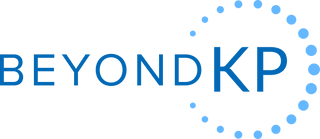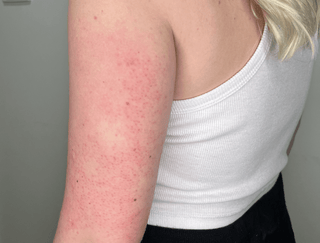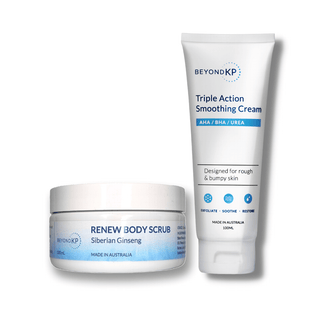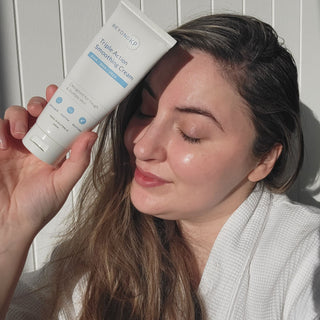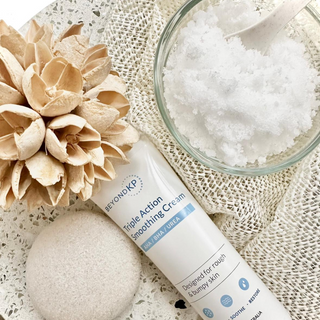Reading time: 10 minutes
Throughout my career as a pharmacist, and now with BeyondKP, it has always been my passion to help & support people with frustrating & persistent skin conditions.
This is something very personal to me - my own skin health journey has been marked by lifelong struggles with eczema, Keratosis Pilaris, and intense dry skin. I know all too well the embarassment and frustration these conditions can cause.
My goal is to address the common myths, stigmas and misconceptions about KP and provide effective guidance on treatment and management strategies - so that those who are impacted by KP can feel more comfortable and confident in their skin.
If you’ve asked the Internet “how do I treat my Keratosis Pilaris?”, then you’ve no doubt discovered an overwhelming number of options and opinions out there… Where do you even start!?
We're going to break down what it means to treat KP - we'll unpack the different treatment options, understand how they affect our skin, and discuss the do’s and don’ts - so that you can tackle those bumps with confidence!
Skip To...
What is Keratosis Pilaris? (The 30-sec version)
KP is a chronic skin condition that affects around 40% of the world’s adult population, and it occurs when an excess of the skin's protein, keratin, builds up and plugs the hair follicles (i.e. keratin plugs). This results in small, raised bumps that commonly appear on the upper arms, thighs, back, and sometimes on the face.
 The nicknames given to the condition - “chicken skin”, "strawberry skin”, “goosebump skin” - hint at what these bumps look like. They often appear red or slightly discoloured, and can be accompanied by dry skin, slight itchiness, inflammation (skin redness) and pigmentation (darker or lighter spots).
The nicknames given to the condition - “chicken skin”, "strawberry skin”, “goosebump skin” - hint at what these bumps look like. They often appear red or slightly discoloured, and can be accompanied by dry skin, slight itchiness, inflammation (skin redness) and pigmentation (darker or lighter spots).
You should always visit a doctor/dermatologist to confirm whether you actually have KP as different skin conditions can look pretty similar. They are best placed to provide a true diagnosis.
Looking for a more in-depth understanding of KP? Check out our deepdive here.
KP treatment options summary
When we search for a KP “treatment”, we hope to find that one miracle cure to banish it forever. However, KP is a long-term skin condition with genetic roots, and unfortunately there isn't a permanent "off-switch" for it.
Nevertheless, there is plenty we can do about it - and we recommend tackling KP with these goals in mind:
- Break down keratin build-up and smooth surface bumps
- Reduce skin inflammation, irritation & redness
- Repair & nourish the skin barrier
- Lessen dark patches and uneven skin tone
Check out this summary table for a quick read on our recommended treatment options for each goal:
| Goal | Treatment Options |
| Break down keratin build-up & smooth surface bumps |
|
| Reduce skin inflammation, irritation & redness |
|
| Repair & nourish the skin barrier |
|
| Lessen dark patches and uneven skin tone |
|
Read on to learn why these recommendations can turn the tables on KP, and to find out the dos and don’ts for effective treatment.
Best (and worst) ways to get rid of KP bumps
Exfoliation is the key to getting rid of those bumps, but for Keratosis Pilaris, not all exfoliating methods are equal.
Before we dive in, it’s worth noting that climate, genetics, sensitive skin & lifestyle can all influence how KP affects our skin - which means what works for one person may not help at all for another.
Let’s break down the different off-the-shelf options out there so that you can find one most suited to your skin!
Exfoliating creams and lotions
Exfoliating creams and lotions are one of the most effective topical treatments for KP - as leave-on products, they remain on your skin allowing for deep exfoliation.
There are a group of chemical exfoliants - “alpha hydroxy acids” (AHAs) and “beta hydroxy acids” (BHAs) - that are widely considered the go-to ingredients for tackling KP.
These products work by dissolving the keratin build-up that clogs hair follicles beneath your skin's outer surface and causes bumps to appear. These exfoliants can work on their own or in tandem with each other to great effect.
If you’re looking for an effective self-care treatment for your KP bumps, exfoliating creams or lotions are your best bet. Look for products that contain one or more of:
- BHAs (salicylic acid) with a concentration of 0.5-2%
- AHAs (lactic acid, glycolic acid) with a concentration of 5-10%
- Urea with a concentration of 5-20%
Some products contain more than one of these - these can prove more effective or give faster results, as the chemicals can work in tandem at different levels within your epidermis for greater effect!
BHAs
Salicylic acid is an oil-soluble BHA exfoliant that can absorb deeply into your skin to break down keratin build-up in pores, while softening and exfoliating dead skin cells. It even has an anti-bacterial and anti-inflammatory effect.
AHAs
Lactic and glycolic acids stand out as the primary AHAs in skincare products. Both are water-soluble exfoliants that work by breaking down the bonds between keratin plugs, facilitating their removal and promoting skin renewal.
Lactic acid has a larger molecular structure, working closer to the skin's surface and proving gentler, ideal for sensitive skin types. It doesn't just exfoliate; it also moisturises, reinforcing the skin's barrier, which is essential for KP management.
Glycolic acid, with its smaller molecular size, can delve deeper into the skin for a more intense exfoliation, making it a go-to for issues such as fine lines, uneven skin texture and dark spots.
Urea
Urea is widely used in dermatology thanks to its unique multitasking capabilities. It is particularly helpful for KP, as it can:
- Promote new cell growth by gently breaking down the outer layer
- Help AHAs and BHAs penetrate deeper into the skin
- Draw water into your skin - hydrating and preserving the moisture barrier
Watch out for...
Due to the potency and prolonged skin contact associated with creams and lotions, there's a risk of irritation, especially if you're new to acids or have sensitive skin, so...
- Start slowly - ideally once a day, and no more than twice a day. I know you want quick results, but these are powerful exfoliants, and overuse can result in skin peeling, increased irritation and over-exfoliation.
- If your product contains AHAs, your skin will be more vulnerable to sun damage - be sure to use a broad-spectrum SPF 30+ sunscreen.
Exfoliating washes
Exfoliating washes or cleansers containing AHAs and BHAs can help to dissolve keratin plugs that cause KP bumps to appear.
Since these washes are rinsed off rather than left on the skin, they're a great option if your skin is too sensitive for creams & lotions, or if you're new to skincare acids.
Exfoliating washes provide a dual action of cleaning and exfoliating, and are great for newcomers to skincare acids as well as those with super sensitive skin due to being gentler than leave-on products.
If you use an exfoliating wash, be sure to allow a minute or two for the product to absorb before rinsing it off, and beware of skin dryness if used frequently. Also, note that washes are amongst the gentlest options for smoothing those bumps, so you may not see fast results.
Physical scrubs
Physical scrubs contain small, gritty particles (sugar, salt, nut shells etc) that manually slough off dead skin cells when massaged onto the skin. Physical scrubs can offer temporary relief and leave our skin feeling smooth after use, but might not be sufficient to deeply address the keratin plugs characteristic of KP.
If you’re a fan of shower scrubs, opt for a gentle scrub and use it in moderation. During use, rub it with your fingers in slow, circular motions.
There are a few things you’ll want to be careful of with physical scrubs:
- Scrubs that are too abrasive, causing micro-tears in the skin if used too vigorously
- Most scrubs will not penetrate deeply enough to break down the keratin build-up that causes bumps to appear
- Using scrubs for continued smoothness requires frequent scrubbing, which can lead to over-exfoliation, worsening inflammation and redness
Exfoliating tools
These are tools like loofahs, brushes, or gloves/mitts used in the shower to exfoliate the skin. They offer surface-level exfoliation, without touching the keratin plug, which is deep in the epidermis, near the root of your hair follicles.
Consider these if you have highly tolerant skin. We only recommend gentle cleansing sponges or soft washcloths that don’t damage or aggravate your skin. These are suitable for regular use, but they should complement, not replace, the work of a quality exfoliant that has AHAs or BHAs (more on that later!).
Aggressive tools that leave your skin feeling red and raw after use. Be especially careful if you have sensitive skin or skin prone to dark spots (pigmentation), as these tools can cause further irritation and inflammation - and may even make the bumps appear darker in colour.
Help with skin redness
Keratosis Pilaris is often accompanied by skin redness and inflammation, which can significantly affect the appearance and feel of the skin. The inflammation and redness are usually our body’s natural response to irritation, often aggravated by the presence of keratin plugs within hair follicles. The inflammation, in particular, can cause discomfort and an intensified red hue in the affected areas.
To tackle skin inflammation, irritation and redness:
- Select a cream or lotion formulated with calming ingredients like aloe vera, colloidal oatmeal, ceramides, chamomile, and zinc which can soothe inflamed skin and alleviate redness. Niacinamide can be particularly effective in reducing inflammation and redness associated with KP
- Regularly apply a broad-spectrum SPF 30+ sunscreen protect sensitive, inflamed skin from further damage.
Repairing dry KP-affected skin
Whenever KP treatment is the topic, exfoliation gets most of the spotlight... naturally smoothing those bumps is the top priority.
However, failing to look after the health of your skin barrier can make your KP symptoms worse, in a couple of ways:
- Dry or damaged skin is prone to further build-up in pores - which can cause more bumps to appear.
- Exfoliating treatments can take away the nutrients and moisture in your epidermis, exacerbating skin dryness and putting your skin at risk of a vicious cycle of KP flare-ups and skin irritation
We recommend that whenever you exfoliate, follow up with a moisturiser afterwards - this can slow the reappearance of bumps and other symptoms and reduce the chance of sudden flare-ups.
Note that choosing the right moisturiser is crucial! Many typical body lotions consist of more than 80% water and lack the nourishing properties and emollients (ingredients that soften your skin) needed to genuinely restore your skin’s health.
When evaluating products, look for:
- A rich cream, ointment or body oil that’s been formulated to target dry skin
- A non-comedogenic product - this means that it has been formulated to minimise clogging of your pores. If you're using AHAs and BHAs to break down build-up in your hair follicles, the last thing you want to do is immediately clog them up again!
- Key ingredients such as urea, ceramides, glycerin, hyaluronic acid, jojoba oil and squalane. These ingredients mimic the skin's natural barrier and moisture components, providing targeted hydration and protective qualities for dry, eczema-prone, and KP skin.
Dealing with uneven skin tone
Post-inflammatory hyperpigmentation (PIH) is the clinical term for the dark spots that can often accompany keratosis pilaris. These can be more prevalent for people with darker skin tones, those who have a family history of PIH, or those who have been scratching or picking at the KP bumps.
PIH is caused by an excess production of melanin, your skin's pigment, in response to inflammation or injury. While they can fade over time, it may take several months or even years for them to disappear completely.
There are some steps you can take to reduce the appearance of these dark spots:
Avoid scratching or picking
Physical contact like picking at your bumps, scratching them and scrubbing them can lead to inflammation and irritation of your KP, increasing your risk of pigmentation.
Scratching and picking can also open wounds and increase risk of infection. As tempting as it may be, let’s leave it to our chemical exfoliants to get the keratin plugs out.
Topical treatments
Certain topical treatments can help to combat inflammation and lighten PIH. These include products formulated with ingredients like salicylic acid, niacinamide, vitamin C, hydroquinone, azelaic acid or licorice root extract, all of which can help to lighten pigmentation over time.
How dermatologists can help
A dermatologist can explore a variety of treatment options with you, like chemical peels, advanced laser therapy or prescription-grade topical applications, which can be more potent and targeted compared to over-the-counter products.
If you struggle with persistent KP or are impacted by post inflammatory hyperpigmentation (PIH), laser therapy (Q Switch YAG laser in particular) has been shown to provide promising results. This kind of laser targets the hair follicles affected by KP to reduces redness, inflammation, and bumps on the skin, improving skin texture and pigmentation after several sessions.
If the distressing state of your KP is leading you to constantly pick at the bumps, impacting your well-being and self-esteem, your dermatologist can offer comprehensive support. They can suggest effective strategies to alleviate physical symptoms and, if necessary, can refer you to a mental health professional to address the emotional stress induced by the condition. This ensures a holistic approach to managing your KP, addressing both its physical symptoms and the accompanying emotional distress.
Ready for your next step? We can help!
I’m hoping that at this point you’ve levelled up your understanding of KP, and are ready to do something about it. As you take this journey, we’re here to support & guide you...
- A Personalised Exfoliation Plan - Reach out to us using this link if you’d like a personalised exfoliation & skincare plan for your KP-affected skin
- Pharmacy-Grade Guidance & Tips - Sign up to our newsletter below or follow us to join our community of KP warriors.
